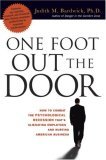Posts
Recommended Resource – One Foot Out The Door
/in Diversity & Inclusion, Recommended Resources/by StrategyDriven
One Foot Out the Door: How to Combat the Psychological Recession That’s Alienating Employees and Hurting American Business
by Judith M. Bardwick, Ph.D.
About the Reference
One Foot Out the Door: How to Combat the Psychological Recession That’s Alienating Employees and Hurting American Business by Dr. Judith M. Bardwick examines the changing employment relationship between American businesses and their workforces and the impact these changes have had on employee engagement and retention. Dr. Bardwick illustrates with hard numbers how employees, once accustomed to high job security, have entered into “a psychological recession” because of the employment uncertainty associated with today’s frequent layoffs, downsizing, rightsizing, and outsourcing. She concludes her work with practical strategies for enhancing employee engagement; thereby increasing job performance and retention.
Benefits of Using this Reference
Success in today’s rapidly evolving business environment requires the full engagement of employees’ knowledge, skills, and experiences focused on the achievement of mission goals. As highlighted by Dr. Bardwick, the continuous reengineering of today’s businesses places a strain on this engagement; one that must be overcome by executives and managers.
StrategyDriven contributors believe accountable, diverse, and inclusive organizations can overcome the “psychological recession” illustrated in One Foot Out the Door and that executives and managers implementing Dr. Bardwick’s recommendations will be better able to fully engage their employees by making them feel that they and their work are valued and significantly contribute to the organization’s success.
Many of the best practice recommendations found on the StrategyDriven website compliment the actions prescribed by Dr. Bardwick in One Foot Out the Door, making this book a StrategyDriven recommended read.
Additional Resources
Interviews with Dr. Bardwick regarding One Foot Out the Door can be enjoyed from the following two websites:
Diversity and Inclusion – What Does Your Environment Communicate?
/in Corporate Cultures, Diversity & Inclusion, Premium/by StrategyDriven
- physical environment
- social environment
- decision environment
- positional environment
- developmental environment
- recognition and rewards environment
Hi there! Gain access to this article with a FREE StrategyDriven Insights Library – Sample Subscription. It’s FREE Forever with No Credit Card Required.
| Sign-up now for your FREE StrategyDriven Insights Library – Sample Subscription
In addition to receiving access to Diversity and Inclusion – What Does Your Environment Communicate?, you’ll help advance your career and business programs through anytime, anywhere access to:
Best of all, it’s FREE Forever with No Credit Card Required. |
Additional Information
As with all self assessments, there exists a wide array of tools that can be employed when examining each organizational environment. These tools range from the concrete direct observation to the less tangible surveys and interviews. Recommendations regarding the collection and synthesis of self assessment data can be found in Evaluation and Control Best Practice 1 – Data Synthesis and the Information Development Model.
Additionally, the most valuable self assessments use standards of excellence as their comparative basis and apply a highly critical eye to the organization’s conditions and performance. Information regarding the application of this high level of scrutiny can be found in:
- Strategic Analysis Best Practice 1 – Integrity without Excuses
- Strategic Analysis Best Practice 2 – advocates diabolic, The Devil’s Advocate
- Strategic Analysis Best Practice 3 – Identify the Hidden Drivers
- Strategic Analysis Best Practice 3 – Identify the Hidden Drivers (Continued)
- Strategic Analysis Best Practice 4 – Independent Assessors
- Self Assessment Best Practice 1 – Executive Sponsorship
- Self Assessment Best Practice 2 – Multidiscipline Teams
StrategyDriven Diversity and Inclusion Forum
/in Diversity & Inclusion/by StrategyDriven
StrategyDriven Contributors
Remaining relevant in today’s hyper-competitive business environment requires the full engagement of an organization’s workforce and the retention of highly talented employees. To accomplish this, leaders must capture the passion and commitment of subordinates by providing them with work that has a meaningful impactful on others and is quantifiablely measurable and rewarded; all while connecting with them on a personal level. Similarly, individuals need to connect with their peers in a way that makes them feel their contributions meaningfully add to the team and the organization’s overall success. Simply put, individuals seek to be valuable to and valued by their organizations; limited only by their abilities and desires. Without this sense of value and connectedness, a job becomes nothing more than the means to a paycheck, productivity declines toward that which is required to maintain employment, and attrition rises as employees seek more fulfilling work; all at great cost to the organization.
|
Increasing workforce diversification challenges all members of an organization attempting to satisfy the individual value proposition. Differences in age, race, gender, religion, and sexual orientation to name but only a few, influence what makes individuals feel valued. Studies have shown the degree to which an individual feels valued by his/her superiors and peers in large part defines his/her work engagement and the subsequent value offered to the organization. Thus, the challenge is a circular one best solved by fostering an organizational culture that respects and embraces diversity and inclusion.
Focus of the Diversity and Inclusion Forum
While there exists a natural association between diversity and inclusion and organizational accountability, this forum will focus on the principles, best practices, and warning flags associated with establishing and maintaining a workplace environment that respects and values individual differences in order to earn full employee engagement and commitment to the achievement of the organization’s goals. The following articles, podcasts, documents, and resources cover those topics critical to enhancing workplace diversity and inclusion.
For additional information on creating a positive, motivating workplace environment, visit the StrategyDriven Employee Engagement Center of Excellence.
Articles
Principles
- What is Diversity and Inclusion? [StrategyDriven Premium Content]
- What Does Your Environment Communicate? [StrategyDriven Premium Content]
- Return On Investment, part 1: Employee Turnover Reduction [StrategyDriven Premium Content]
- Return On Investment, part 2: Employee Distraction Reduction [StrategyDriven Premium Content]
- Return On Investment, part 3: Employee Productivity Enhancement [StrategyDriven Premium Content]
- Return On Investment, part 4: Litigation, Fine, and Payout Reduction [StrategyDriven Premium Content]
Best Practices
- Best Practice – Know the Holidays [StrategyDriven Premium Content]
- Best Practice – Performance Measurement [StrategyDriven Premium Content]
Warning Flags
- Warning Flag – ad hominem: Personal, Not Issue Attacks [StrategyDriven Premium Content]
StrategyDriven Expert Contributor Articles
- Rocking the Workplace: How the Millennial Generation is Shaking Up the Way You Do Business by Lynne Lancaster and David Stillman
- Management vs. Leadership Mindset: What Millennial Employees Need to Know As They Enter Leadership Roles by Lisa Orrell
StrategyDriven Podcasts
StrategyDriven Podcast – Video Edition
StrategyDriven Podcast – Special Edition
- An Interview with Michael Gurian, author of Leadership and the Sexes examines the equal but different intelligence of men and women.
- An Interview with Tammy Erickson, author of What’s Next, Gen X? examines generational relationships within the workplace and the actions Gen Xers should take to ready and position themselves to be the next group of corporate and civic leaders.
- An Interview with Lynne Lancaster and David Stillman, authors of The M-Factor, part 1 of 2 examines how to successfully integrate Millennials into the workforce from the perspectives of the Traditionalists, Boomers, and Gen Xers already there and the incoming Millennials themselves.
- An Interview with Lynne Lancaster and David Stillman, authors of The M-Factor, part 2 of 2 examines how to successfully integrate Millennials into the workforce from the perspectives of the Traditionalists, Boomers, and Gen Xers already there and the incoming Millennials themselves.
Documents
Tools and Templates
- Cost of Employee Attrition [StrategyDriven Premium Content]
- Cost of Employee Distraction [StrategyDriven Premium Content]
- Value of Employee Productivity [StrategyDriven Premium Content]
Resources
Books
- First, Break All the Rules by Marcus Buckingham and Curt Coffman
- One Foot Out the Door by Judith Bardwick
Reports
- Corporate Diversity Still Coming Up Short for Women by Calvert Investments
Training Courses
Organizational Accountability – Pillars of Accountability
/in Organizational Accountability, Premium/by Nathan Ives
StrategyDriven Contributors
Building an accountable organization can be a long and arduous task; renovating an entitlement organization even more difficult. During this construction project, many able builders will be lost, the victims of a harsh environment that naturally exists between the competent who seek the rightfully earned rewards of performance-based accountability and the low performers struggling to hold on to their positions of power and the accompanying easy life organizational indifference and years of clock-punching bestowed upon them.
Hi there! Gain access to this article with a StrategyDriven Insights Library – Total Access subscription or buy access to the article itself.
| Subscribe to the StrategyDriven Insights Library
Sign-up now for your StrategyDriven Insights Library – Total Access subscription for as low as $15 / month (paid annually). Not sure? Click here to learn more. |
Buy the Article
Don’t need a subscription? Buy access to Organizational Accountability – Pillars of Accountability for just $2! |
About the Author


 Organizational accountability is built on the premise that individuals are equitably rewarded based on their contribution to the accomplishment of the organization's goals consistent with its ethical values. Performance, therefore, becomes more than just 'making the numbers.'
Organizational accountability is built on the premise that individuals are equitably rewarded based on their contribution to the accomplishment of the organization's goals consistent with its ethical values. Performance, therefore, becomes more than just 'making the numbers.'